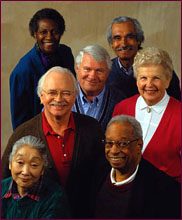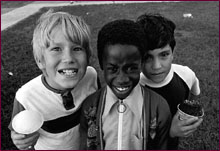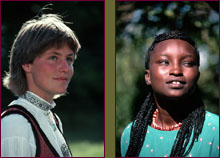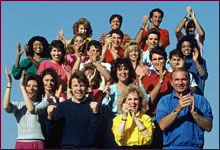 |

|
A proponent's perspective by George W. Gill Slightly over half of all biological/physical anthropologists today believe in the traditional view that human races are biologically valid and real. Furthermore, they tend to see nothing wrong in defining and naming the different populations of Homo sapiens. The other half of the biological anthropology community believes either that the traditional racial categories for humankind are arbitrary and meaningless, or that at a minimum there are better ways to look at human variation than through the "racial lens." Are there differences in the research concentrations of these two groups of experts? Yes, most decidedly there are. As pointed out in a recent 2000 edition of a popular physical anthropology textbook, forensic anthropologists (those who do skeletal identification for law-enforcement agencies) are overwhelmingly in support of the idea of the basic biological reality of human races, and yet those who work with blood-group data, for instance, tend to reject the biological reality of racial categories.
Findings First, I have found that forensic anthropologists attain a high degree of accuracy in determining geographic racial affinities (white, black, American Indian, etc.) by utilizing both new and traditional methods of bone analysis. Many well-conducted studies were reported in the late 1980s and 1990s that test methods objectively for percentage of correct placement. Numerous individual methods involving midfacial measurements, femur traits, and so on are over 80 percent accurate alone, and in combination produce very high levels of accuracy. No forensic anthropologist would make a racial assessment based upon just one of these methods, but in combination they can make very reliable assessments, just as in determining sex or age. In other words, multiple criteria are the key to success in all of these determinations.
As a middle-aged male, for example, I am not so sure that I believe any longer in the chronological "age" categories that many of my colleagues in skeletal biology use. Certainly parts of the skeletons of some 45-year-old people look older than corresponding portions of the skeletons of some 55-year-olds. If, however, law enforcement calls upon me to provide "age" on a skeleton, I can provide an answer that will be proven sufficiently accurate should the decedent eventually be identified. I may not believe in society's "age" categories, but I can be very effective at "aging" skeletons. The next question, of course, is how "real" is age biologically? My answer is that if one can use biological criteria to assess age with reasonable accuracy, then age has some basis in biological reality even if the particular "social construct" that defines its limits might be imperfect. I find this true not only for age and stature estimations but for sex and race identification.
Position on race Where I stand today in the "great race debate" after a decade and a half of pertinent skeletal research is clearly more on the side of the reality of race than on the "race denial" side. Yet I do see why many other physical anthropologists are able to ignore or deny the race concept. Blood-factor analysis, for instance, shows many traits that cut across racial boundaries in a purely clinal fashion with very few if any "breaks" along racial boundaries. (A cline is a gradient of change, such as from people with a high frequency of blue eyes, as in Scandinavia, to people with a high frequency of brown eyes, as in Africa.)
So, serologists who work largely with blood factors will tend to see human variation as clinal and races as not a valid construct, while skeletal biologists, particularly forensic anthropologists, will see races as biologically real. The common person on the street who sees only a person's skin color, hair form, and face shape will also tend to see races as biologically real. They are not incorrect. Their perspective is just different from that of the serologist. So, yes, I see truth on both sides of the race argument. Those who believe that the concept of race is valid do not discredit the notion of clines, however. Yet those with the clinal perspective who believe that races are not real do try to discredit the evidence of skeletal biology. Why this bias from the "race denial" faction? This bias seems to stem largely from socio-political motivation and not science at all. For the time being at least, the people in "race denial" are in "reality denial" as well. Their motivation (a positive one) is that they have come to believe that the race concept is socially dangerous. In other words, they have convinced themselves that race promotes racism. Therefore, they have pushed the politically correct agenda that human races are not biologically real, no matter what the evidence. Consequently, at the beginning of the 21st century, even as a majority of biological anthropologists favor the reality of the race perspective, not one introductory textbook of physical anthropology even presents that perspective as a possibility. In a case as flagrant as this, we are not dealing with science but rather with blatant, politically motivated censorship. But, you may ask, are the politically correct actually correct? Is there a relationship between thinking about race and racism?
Does discussing human variation in a framework of racial biology promote or reduce racism? This is an important question, but one that does not have a simple answer. Most social scientists over the past decade have convinced themselves that it runs the risk of promoting racism in certain quarters. Anthropologists of the 1950s, 1960s, and early 1970s, on the other hand, believed that they were combating racism by openly discussing race and by teaching courses on human races and racism. Which approach has worked best? What do the intellectuals among racial minorities believe? How do students react and respond? Three years ago, I served on a NOVA-sponsored panel in New York, in which panelists debated the topic "Is There Such a Thing as Race?" Six of us sat on the panel, three proponents of the race concept and three antagonists. All had authored books or papers on race. Loring Brace and I were the two anthropologists "facing off" in the debate. The ethnic composition of the panel was three white and three black scholars. As our conversations developed, I was struck by how similar many of my concerns regarding racism were to those of my two black teammates. Although recognizing that embracing the race concept can have risks attached, we were (and are) more fearful of the form of racism likely to emerge if race is denied and dialogue about it lessened. We fear that the social taboo about the subject of race has served to suppress open discussion about a very important subject in need of dispassionate debate. One of my teammates, an affirmative-action lawyer, is afraid that a denial that races exist also serves to encourage a denial that racism exists. He asks, "How can we combat racism if no one is willing to talk about race?"
In my experience, minority students almost invariably have been the strongest supporters of a "racial perspective" on human variation in the classroom. The first-ever black student in my human variation class several years ago came to me at the end of the course and said, "Dr. Gill, I really want to thank you for changing my life with this course." He went on to explain that, "My whole life I have wondered about why I am black, and if that is good or bad. Now I know the reasons why I am the way I am and that these traits are useful and good." A human-variation course with another perspective would probably have accomplished the same for this student if he had ever noticed it. The truth is, innocuous contemporary human-variation classes with their politically correct titles and course descriptions do not attract the attention of minorities or those other students who could most benefit. Furthermore, the politically correct "race denial" perspective in society as a whole suppresses dialogue, allowing ignorance to replace knowledge and suspicion to replace familiarity. This encourages ethnocentrism and racism more than it discourages it. Dr. George W. Gill is a professor of anthropology at the University of Wyoming. He also serves as the forensic anthropologist for Wyoming law-enforcement agencies and the Wyoming State Crime Laboratory. Does Race Exist? | Meet Kennewick Man Claims for the Remains | The Dating Game | Resources Transcript | Site Map | Mystery of the First Americans Home Editor's Picks | Previous Sites | Join Us/E-mail | TV/Web Schedule About NOVA | Teachers | Site Map | Shop | Jobs | Search | To print PBS Online | NOVA Online | WGBH © | Updated November 2000 |
 Dr. George Gill (and Jaime Stuart)
Dr. George Gill (and Jaime Stuart)
 Where does George Gill stand in the
"great race debate?" Read on.
Where does George Gill stand in the
"great race debate?" Read on.
 While he doesn't believe in
socially stipulated "age" categories, Gill says, he can "age" skeletions with
great accuracy.
While he doesn't believe in
socially stipulated "age" categories, Gill says, he can "age" skeletions with
great accuracy.
 "I am more accurate at
assessing race from skeletal remains that from looking at living people
standing before me," Gill says.
"I am more accurate at
assessing race from skeletal remains that from looking at living people
standing before me," Gill says.
 "Clines" represent
gradients of change, such as that between areas where most people have blue
eyes and areas in which brown eyes predominate.
"Clines" represent
gradients of change, such as that between areas where most people have blue
eyes and areas in which brown eyes predominate.
 Does discussing the concept of race promote racism?
Does discussing the concept of race promote racism?
 "How can we combat racism," asks an affirmative-action lawyer, "if
no one is willing to talk about race?"
"How can we combat racism," asks an affirmative-action lawyer, "if
no one is willing to talk about race?"